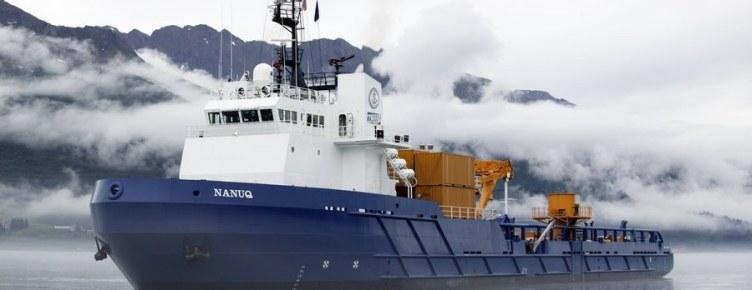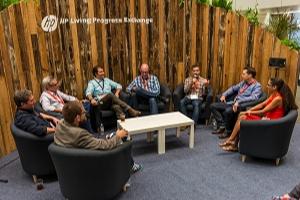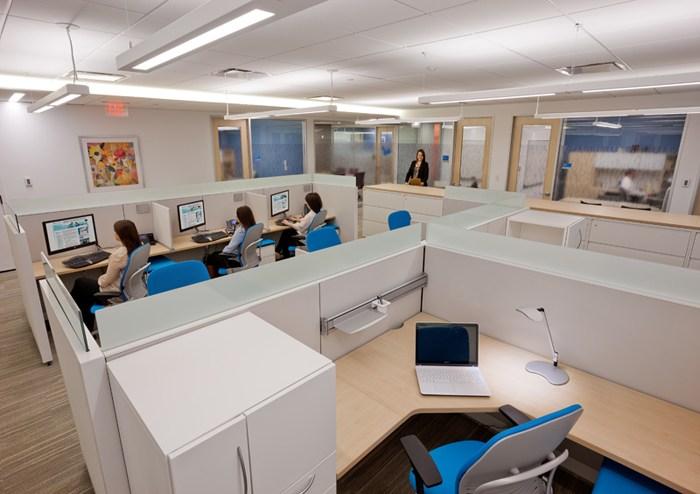BSR Conference 2014 Livestream Video


The TriplePundit team is at BSR 2014 this year in New York and the line up is better than ever. If you can't make it this year in person, don't worry, we've got you covered. All plenaries and most other major speakers will be broadcast below. Just bookmark this page and hit play!
For complete coverage of the BSR Conference 2014, visit http://bsr14.org/
Engage and Excel: How Corporate Responsibility Improves the Bottom Line


By Shannon Schuyler
Employee engagement tops many CEO agendas — not surprising, considering a more engaged workforce means better work quality and longer tenure. These benefits directly impact the bottom line, increasing productivity and efficiency and fueling innovation. Employees most committed to their organizations put in 57 percent more effort on the job and are 87 percent less likely to resign than their disengaged counterparts, according to the Corporate Executive Board.
Despite CEOs’ widespread agreement that employee engagement is highly desirable, many companies don’t deploy all available resources to foster it. Too frequently, employee engagement is siloed as a human resources (HR) function, limited to areas like professional development and compensation. Although HR has an important role to play, other crucial levers, such as corporate responsibility (CR), exist for achieving sustained employee engagement. Further emphasizing this tie-in between CR and employee engagement, a recent survey by CECP, a coalition of CEOs focused on societal investment, revealed 36 percent of CEOs said employee support would make the biggest impact on a company’s decision to expand its investment in the community.
At PwC, we recently moved beyond the usual documentation of CR efforts by measuring the employee engagement return on our CR investment. After assessing the level of CR commitment among our more than 39,000 U.S. partners and staff, we triangulated this data with performance reviews, retention and productivity. We further analyzed the results by examining market, practice area and staff class.
Generally, we found that as the level of CR activity rose, so did performance and length of tenure. Moreover, the greater employees’ CR engagement, the more likely they were to be high performers. Fifty-five percent of employees with one CR activity were high performers, with an average tenure of 6.7 years. Among employees with two or more CR activities, 60 percent were high performers, with an average tenure of 7.4 years.
Our study also showed how specific types of CR, such as nonprofit board seats, correlate with tenure. One of our partners in San Jose, California, for example, serves on the local and national boards of an organization that uses entrepreneurship to excite and propel disengaged, low-income youth through high school and into college. He recently helped facilitate a three-and-a-half month pro bono project, which included analyzing the organization’s mentor recruitment strategy and developing recommendations for improvement. The organization has implemented five of these recommendations so far, resulting in earlier recruitment of mentors and enhanced mentor experience. And we now have many more of our firm’s partners and staff volunteering as mentors with the organization.
We often see this type of two-way relationship with CR and employee engagement. Encouraged by the firm, a partner invests heavily in his board activity, leading to increased firm investment in the non-profit, and strengthening the partner’s engagement with the local office and beyond.
Our findings dispel the myth that highest achievers lack time for CR. In fact, they demonstrate that CR motivates high achievers to pitch in, and the linkage between increased firm success and CR helps fuel CR investment. This represents a marked cultural shift. In FY 2010, we found that volunteer hours were the highest on average among employees receiving the lowest ratings, and employees devoted an average of three hours to CR. Three years later, in FY 2013, average volunteer hours were highest among those receiving the top ratings, and average hours per employee had doubled.
How did we get here? First, we aim to increase employee engagement through CR initiatives that not only meet important community needs, but also build on shared values, tap in-house experience and provide opportunities for leadership and growth.
Second, to foster engagement through CR, we focus heavily on enabling our workforce. We want our people’s engagement to fit their work and home life, and to provide maximum benefits from participation. Our efforts would backfire if, for example, we asked our people to teach financial literacy but penalized employees for time away from the office, created programs that lacked skill-building opportunities, or pushed our people to devote time to a CR program that was unimportant to them.
Companies that embrace the notion of 100 percent CR engagement must embed CR in every facet of their employees’ experience: from onboarding to milestone courses, to performance and planning discussions, and even into the alumni ranks. This process also must take into account geography, line of business, gender and minority diversity, and level.
Being a good corporate citizen and leveraging CR to maximize employee engagement are imperatives for today’s companies. Driving business value while bettering society is an opportunity the business community can’t afford to pass up.
Image credit: PwC
Shannon Schuyler is a Principal and CR Leader at PwC, as well as a member of PwC’s Global CR Board and President of the PwC Charitable Foundation, Inc. To learn more about PwC’s approach to fostering employee engagement to drive Corporate Responsibility, see “The Keys to Corporate Responsibility Employee Engagement.”
Shell Seeks 5 More Years for Arctic Drilling


Despite spending eight years and $6 billion — with no oil production to show for its efforts — Royal Dutch Shell is asking the U.S. government for another five years to drill in the Arctic.
Earlier this year, Shell sent a letter to the Department of the Interior and its Bureau of Safety and Environmental Enforcement (BSEE), requesting that its Arctic leases — which expire in 2017 — be paused for five years while the company regroups and attempts to restart drilling operations. The letter was made public late last month by the environmental group Oceana, after obtaining it through a Freedom of Information Act request. Oceana and other groups have sued to block the Arctic exploration.
Shell’s record in the Arctic to date, featuring a string of accidents, is lackluster to the say the least. The Natural Resources Defense Council has noted that Shell’s efforts “illustrate like nothing better just how dangerous it is to drill in the Arctic”:
- July 2012: Shell Oil's Noble Discoverer drill ship drags anchor and nearly drifts ashore in Dutch Harbor, Alaska.
- September 2012: Caught off guard by sea ice, Shell is forced to halt drilling just one day after it started.
- September 2012: In an initial test in Puget Sound, Washington, Shell's Arctic oil spill containment system is "crushed like a beer can."
- October 2012: The CEO of French oil giant Total says drilling in the Arctic is too risky.
- November 2012: The Noble Discoverer catches fire.
- Dec. 31, 2012: The Kulluk drilling rig breaks loose from tow lines five times in heavy storm and runs aground off Kodiak Island, Alaska.
According to a recent Bloomberg news report, Shell says setbacks and legal delays could push the start of drilling past the 2017 expiration of some leases. The oil major’s letter to the Interior Department said “prudent” exploration before leases expire is now “severely challenged.”
“Despite Shell’s best efforts and demonstrated diligence, circumstances beyond Shell’s control have prevented, and are continuing to prevent, Shell from completing even the first exploration well in either area,” Peter Slaiby, vice president of Shell Alaska, wrote to the regional office of the BSEE.
“Ultimately, Shell has no one to blame but itself,” said Michael LeVine, Pacific senior counsel for Oceana, based in Juneau, Alaska. “The government should not bend the rules to accommodate Shell or any other company just because that company spent a lot of money."
Bloomberg’s article continued that Shell has left open the possibility of returning to Arctic drilling as soon as next year. Spokesman Curtis Smith said that timeline remains on the table. “We’re taking a methodical approach to a potential 2015 program,” Smith said in an e-mail.
The U.S., which is revising drilling safety regulations for the Arctic, has ordered that any drilling in the Arctic end each year before Oct. 1, when ice starts forming.
Shell estimates that the Arctic holds around 30 percent of the world’s undiscovered natural gas and 13 percent of its yet-to-find oil. “This amounts to around 400 billion barrels of oil equivalent, 10 times the total oil and gas produced to date in the North Sea. Developing the Arctic could be essential to securing energy supplies for the future, but it will mean balancing economic, environmental and social challenges.”
With those numbers beckoning it’s easy to see the lure of the Arctic for Big Oil, but it’s also easy to see from the billions that Shell has foolishly wasted there that it’s way too risky.
Numi Tea Brings Fair Trade to Madagascan Turmeric Farmers


This is part of a series on "The Future of Fair Trade," written with the support of Fair Trade USA. A 501 (c) (3) nonprofit organization, Fair Trade USA is the leading third-party certifier of Fair Trade products in the United States. To follow along with the rest of the series, click here.
By Brian Durkee of Numi Organic Tea
A member of the ginger family, turmeric has caught the attention of wellness practitioners and health enthusiasts for centuries. Given its culinary versatility and medicinal properties (not to mention its vibrant color!), it’s no wonder that we are seeing the root become a mainstay of diets around the world. People are turning to turmeric, and we are excited to do the same.
With its innumerable health benefits, we knew that we wanted to incorporate turmeric into a brand new tea collection at Numi Tea. We wanted tastes that would complement the earthy/robust flavor of the root; we wanted profiles that would mirror the vibrancy of the spice; we wanted a tea collection that highlighted the wonder of turmeric. And, perhaps most importantly, we wanted our new tea line to be on-par with the sustainable practices that are the foundation of all of our blends. All in all, we wanted to utilize a turmeric that was Fair Trade Certified.
One year ago today, however, there was a very limited supply of Fair Trade Certified turmeric on the market. We found ourselves faced with two options: develop a line of turmeric teas that were not certified Fair Trade, or help an existing turmeric farm become certified. As you can probably imagine, the second option won our hearts.
In early 2013, we worked with our partners to find an incredibly high-quality turmeric. They had recently helped a farm group in Madagascar become certified in growing organic turmeric – and it was the best turmeric they had ever seen. After a few conversations with both parties, we decided that we had found our turmeric. “This turmeric is perfect,” we told the farm group in Madagascar, “but we would like to take this to the next level and help you get Fair Trade Certified.”
The process of Fair Trade Certification happens in roughly five steps:
- The farm applies for certification
- The application is reviewed
- An audit takes place on the farm
- The audit documentation is reviewed
- Certification is either granted or not
To help this turmeric farm in Madagascar through these steps, Numi Organic Tea helped fund the process. We contributed thousands of dollars that went not only towards the cost of certification fees, but also toward the tools and equipment they needed to get their farm up to the right level.
We are thrilled to say that the Madagascar farm group received Fair Trade Certification in early 2014, and that Numi is the first brand to purchase organic, Fair Trade Certified turmeric from them. The group (which has nearly 130 members working directly with turmeric) is part of a larger co-operative comprised of several village clans, totaling approximately 400 members. This group, 130 members, is now both organic and Fair Trade Certified.
So, why does this matter? Besides helping to meet our standards of producing a socially responsible product, why is it important that Numi took the steps to help get this farm Fair Trade Certified?
First and foremost, Fair Trade Certification helps improve the lives and the workplace environments of workers. The certification guarantees fair conditions, and helps empower the community that is directly connected to the farm. Alongside each Fair Trade Certified good is something known as a “Fair Trade premium.” This premium is an additional cost that purchasers (such as Numi) pay for Fair Trade Certified goods. These premiums go directly to the farm groups themselves, where usage is decided upon democratically.
In the case of turmeric, the premium is quite high (around 15 percent of the market price). This is two to three times higher than the premiums that are paid for most tea and herbs! What does this mean? This means that for each pound of turmeric that a farm produces, we pay approximately 85 cents more than the market price. That “extra” money is given directly to the farms, who vote democratically on how it will be used. In the case of our turmeric partners, they intend to use the money to improve their current drinking infrastructures. With nearly 1 billion people without access to clean water, this is something about which we are very passionate!
With this new partnership, Numi has helped expand the Fair Trade Certified products that are available on the market, which increases the number of sources and resonates globally. This turmeric farm group in Madagascar will continue to use Fair Trade premiums to help better their unionized co-op, and plan to add 100 turmeric farmers in the next year.
We will continue working to identify new Fair Trade opportunities in our industry, as we are always looking for ways to bring sustainable, socially responsible and Fair Trade Certified products to the market.
Images courtesy of Fair Trade USA
Oceana Report Claims Fraud Rampant in Shrimp Industry


Shrimp is one of the more popular proteins in the U.S., eaten by plenty of folk who otherwise would never get close to a fish or mollusk. But the shrimp industry has been dogged by a bevy of problems, from reports of rampant slave labor to the pollution generated by shrimp farms across the world. Now the ocean conservation advocacy group Oceana alleges that the industry is duping consumers on the type of shrimp, along with the sourcing, of the products they are buying.
The report focused on shrimp purchased in a few areas within the United States. Oceana claims the misrepresentation of labels is an ongoing problem within the shrimp industry, and insists companies must do more to disclose what kind of shrimp is within a package or on a restaurant plate, and state where it is from. By testing dozens of products in New York City, Portland, Washington D.C., and along the coast of the Gulf of Mexico, Oceana has arrived to several conclusions, none of which will thrill consumers, even if buying sustainably is not a priority for them.
According to Oceana, New York is the locus for what is wrong in the shrimp industry. The NGO’s author’s claimed two-thirds of the stories they visited sold misrepresented shrimp, and that 43 percent of all shrimp were improperly labeled. Farmed whiteleg shrimp, a common farmed product, was often, in Oceana’s words, “disguised” as wild caught shrimp. Another east coast city, Washington, also fared poorly on the transparency front. The survey found almost half of all products on restaurant menus were misrepresented, and over 80 percent did not list the type of shrimp on any of their dishes.
Nationwide, the biggest problem Oceana presents is that 30 percent of all shrimp sold as “wild” or “Gulf” shrimp was in reality farmed shrimp. During the scope of the survey, Oceana also found that DNA testing revealed 40 percent of the shrimp species collected consisted of varieties sold in the U.S. And to further its point that consumers simply do not have enough information, the survey’s authors complained that 30 percent of the labels from shrimp sold in supermarkets lacked information the country of origin or had no disclosures whether the shrimp was caught wild or farmed. One in five labels offered neither type of information.
So what can consumers do? Oceana recommends that consumers should ask retailers and restaurateurs more questions, buy only traceable seafood and for the ambitious, contact the new presidential task force devoted to sustainable seafood. Indeed, consumers can also learn more about the industry, about the environmental effects from producing farmed shrimp in ponds and the egregious human rights violations that are repeated in the global shrimping and fishing industry. The Oceana report makes passing reference to shrimp’s ecological effects, as well as mentioning its past report on the overall fraud within the fishing industry.
True, this report was centered on labeling, but Oceana only focued on environmental issues and made no reference in the report to the slavery and the human cost of producing shrimp. Unfortunately, that was a lost opportunity, because what is occurring in nations including Thailand could really motivate consumers to lay off the shrimp cocktail unless they know it was produced responsibility, both socially and environmentally. Consumers need to know more about the global effects of the shrimp industry than just a revelation that a few cities in the U.S. are selling mislabeled shrimp.
Image credit: Oceana
After a year in the Middle East and Latin America, Leon Kaye is based in California again. Follow him on Instagram and Twitter. Other thoughts of his are on his site, greengopost.com.
Climate Change: Sell the Sizzle


By Felicity Carus
The day before the Sustainable Brands 2014 conference in London opened, the United Nations’ Intergovernmental Panel on Climate Change (IPCC) published its first major report since 2007. At 1,552 pages long, the Synthesis Report is indigestible to all but the most die-hard climate activist, policy wonk or scientist. But its central message boils down to this: We must quit fossil fuels altogether by 2100 or face catastrophe.
This is not news people want to hear; not even sustainability professionals who have flown in from Hong Kong or Israel want to hear it. So, how can we expect the man or woman zooming past the Lancaster Hotel next to Hyde Park to get out of their cars and onto the bus, particularly when it's raining in London?
The fact is that climate catastrophe is not even news at all. Sure, the world is a different place since the last IPCC report came out in 2007: The U.S. has a climate-changing president; the financial crisis took a chunk of money out of everyone's pocket; and the momentum for action at the Copenhagen in 2009 has run out of steam despite the frenetic pace of adoption for solar and wind.
But the storytellers -- the journalists, the brand strategists and sustainability marketers in this particular sustainability narrative – have failed to connect consumers enough to inspire engagement with this crisis on any significant scale to make a real impact.
Today's workshop led by Daianna Karaian, senior brand strategist at Futerra, examined effective storytelling because "the connection with brands and consumers was often broken."
"We look at our customers through market research or reams of data - that's massively important, but at the end of the day it's even more important to remember that our customers are real people, just like us."
Futerra are the folks who brought us Sell the Sizzle a founding theory that if you create a vision of the future that is better than the present, people will act on climate change without question. Asking people to give up things that are of value to them without a better solution is not going to change the world or our regard for it.
Nike gets it right because they sell a functional product, an experience that makes someone feel good about themselves if they reach a new PB, and organised events makes people feel connected with a wider community, she said.
"The best way to connect is to find what's in it for them, by finding the importance of sustainability issues for your business and what's actually important and make those connections that are really going to resonate and connect in that sweet spot between sustainability and customer benefit."
Stars Wars makes a good allegory most people can understand: good vs bad, with a mentor who provides a gift to help the hero overcome a challenge or crisis. But brands should never become the hero, she warned. If you think about it, when a brand becomes the 'centre' of a story, it's usually for negative reasons.
But like all good stories, there should be a moral at the finale - a universal truth that everyone can connect with, eg it's what's inside that counts, to succeed we must first believe that we can or people are afraid of change but things always change.
When storytelling goes right, we get results like the Meet the Superhumans advert for the Paralympic Games in 2012 and the Chain of Good advertising Innocent fruit juice.
Storytelling can delight and amuse audiences while carrying serious messages. Follow the Frog from the Rainforest Action Network and the Lazy Environmentalist from WWF Canada do so to good affect.
[embed]https://www.youtube.com/watch?v=LQ6HMshKPPc[/embed]
But the oxytocin feelgood chemicals can go too far and make audiences (at least some of them) feel manipulated. Delegates were only too happy to watch a heart-warming tale about a father coming to terms with his daughter's sexuality and the 'journey' it has taken him only, until the end credit rolled onto the screen for expedia. Some people felt cheated and emotionally manipulated.
Such is the power of storytelling that we need to take care with the audience's trust, to remain authentic and not stray too far from the core values of a product.
Sustainability story telling has got caught in a rut, said James Payne, strategy director at Given, a marketing agency in London that has developed a "substance wayfinder" for brands.
But did the Futerra storytelling process work? Well, the group I was with managed to turn the International Youth Hostels -- a chain of 3,500 low-budget locations in 90 countries -- into an opportunity to offer life-changing experiences that connect people with local communities and release them from day-to-day isolation without costing the earth (to them or the environment).
A delegate from BP challenged the group to make that fit for his company. Well, it's more of a challenge certainly. But one which storytellers both sides of the newsdesk must tackle with greater intensity and imagination than ever before.
Certainly the IPCC could improve the way it connects with its 'customers', ie earthlings.
"Climate change in some ways is like the financial sector where there's a lot of jargon, there's a lot of technical terms and there are a lot of big, system wide conversations," said Karaian in later conversation.
"It's really difficult for just the normal person on the street to connect that with their own lives and what choices they can make. Not just at home to do things like turn off the lights or insulate their homes, but also what they can do as voters and if we all came together as individuals and looked at what was really important to us and the kind of life that we want to be living 10, 20, 50, 100 years from now."
Let's hope by the time the sixth IPCC report arrives, the storytelling will be powerful enough to prompt action.
Image credit: Sustainable Brands
Is 'Connect a Million Minds' Improving STEM Skills?


By Phil Preston
In an increasingly technical world, there is a shortage of STEM (science, technology, engineering and mathematics) skills in the workforce. I asked Time Warner Cable’s VP of Community Investment, Milinda Martin, about the impact of their flagship Connect a Million Minds program.
In a recent announcement, Symantec committed to engaging one million students in STEM skills by 2020. Time Warner Cable has been on this path since 2009. It saw the lack of STEM skills as a constraining factor on its future workforce and decided to look for win-win outcomes.
Phil Preston: The Connect a Million Minds initiative appears to work on many levels. It is framed as a philanthropic project, however it also has elements of shared value because, indirectly, you are improving your future workforce, the competitiveness of American industry and your own business prosperity. Can you tell us how the focus on STEM skill development came about?
Milinda Martin: We selected STEM for a variety of reasons, and you have hit on one in your introduction: We need STEM-educated workers for our industry. We know that the U.S. is not training enough students in these skills to the point where there is a gap between open positions and skilled workers taking them -- not just in cable, but in all STEM-dependent industries. However, that was just one reason why we chose Connect a Million Minds as our philanthropic platform.
We also want to positively impact communities, and we know that STEM jobs are high paying and can lift a family out of poverty. We feel that financially stable communities not only are better for the individuals that live in them, but also for the businesses that provide services to them.
PP: Can you tell us how the program works and the number of young minds ‘connected’?
MM: When we launched Connect a Million Minds in November 2009, our goal was to donate $100 million in cash and in-kind support to raise awareness around STEM. We launched several initiatives to achieve this, including:
- Hands-on STEM experiences, solely in the after-school space, and targeted at middle school youth. To reach these early teenagers, we work with nonprofit organizations that develop programs based on what kids love – music, sports, video games, fashion, movies and TV, and social media – and provide hands-on learning to those areas, so that we can make the connection between what they learn in the classroom, and how it is applied to their passions. Our goal is to show kids that, if they want a career in the things they love, they should seriously consider staying with mathematics and science.
- To date, we have donated more than $200 million in public service announcements, stressing the importance of STEM skills for our nation’s youth.
- We built an online “Connectory” that allows nonprofit organizations to publicize their after-school STEM programs and parents to research after-school programs near them. Our Connectory, which is housed on the Connect a Million Minds website, has approximately 5,500 nonprofit partners, posting almost 12,000 STEM programs across the country.
- We created a pledging campaign, to ensure we were measuring our results. Parents, teachers, nonprofit providers, caregivers, museum volunteers and many more can pledge to connect a child to a hands-on STEM experience. While we hoped to collect one million pledges by November 2014, we actually passed the milestone in May 2014.
- We engaged our employees in volunteering to help us deliver the program. So far this year, more than 20 percent of our employee base has signed up to volunteer, and they have donated more than 15,000 hours year to date.
MM: We ask every nonprofit partner to provide measurement of our program partnerships, and this includes not only how many kids participate, but also pre-program and post-program surveys on their engagement and knowledge with respect to STEM. We have also worked with several national partners to create curricula that can be utilized by any nonprofit, so that we are providing hands-on STEM experiences, even in areas where we do not operate or with organizations we do not directly fund. This is all meant to increase our nation’s awareness of the STEM crisis and to provide informal learning opportunities for all communities.
Measuring long-term impact, when we focus on the middle school age group, is a challenge. We have anecdotal evidence that kids who go through our funded programs sign up for high school math and science, but tracking individual performance beyond the length of the after-school program is difficult and costly for our partners. What we do know is that kids who participate in our funded after-school programs graduate from high school at greater rates than those who do not attend. In fact, some of our nonprofit partners have 100% high school graduation rates in communities that have nearer to 40 percent graduation rates overall.
PP: Congratulations on your success to date. It is certainly encouraging to hear about proactive community engagement strategies and the rationale for doing so.
Image credit: Connect A Million Minds website
Phil Preston helps employees and businesses devise community engagement strategies. He can be contacted via [email protected] or followed @PhilPrestonTwit
Watch Out for That Cliff: The Urgency of Driving Sustainability in Business


By Chris Librie
Picture Indiana Jones in the blockbuster film "Raiders of the Lost Ark." He’s galloping on a white stallion in hot pursuit of a convoy transporting the lost Ark. In true action-hero style, Jones leaps from the horse and drops himself inside the truck carrying the artifact. Eventually, Jones takes control of the truck. As the convoy continues down the winding jungle road, a car pulls up alongside — its occupants intent on taking out our hero. The two vehicles barrel toward a sharp S-curve. In the final second, Jones makes a sharp turn, narrowly avoiding the cliff. The second car and its passengers are shown falling to their demise.
What does this adrenaline-charged scene from the popular action film have to do with sustainability?
“We must have a sense of urgency,” said Brad Tomm, senior manager of campus operations and sustainability at Zappos. “We cannot merely slow down. We must steer completely away from the cliff.”
Tomm shared this analogy during a HP Living Progress Exchange (LPX) discussion forum at the recent SXSW Eco conference in Austin, Texas. The LPX, hosted by HP and moderated by GlobeScan, brings together sustainability experts and opinion leaders to learn from each other, inspire fresh thinking and share best practices. In addition to Zappos, I was joined in one of two LPX sessions by leaders from ZipCar, Conservation International, Adobe, The North Face, National Audubon Society, Chicago Botanic Garden and SolarCity.
And this week, HP is hosting two more LPX sessions at Sustainable Brands London, as well as launching an ongoing global online discussion — open to everyone — on the Convetit Think Tank.
It’s not that we spend a lot of time discussing 1980s adventure films in our HP Living Progress Exchange, but Tomm’s analogy is a good one.
We, as a society, are barreling full-steam ahead toward a future that can’t sustain us.
Like Jones, we have a choice:
- Take no action and meet the cliff quickly
- Reduce our acceleration, which keeps on a dangerous path but buys us a little more time
- Or turn the wheel and avoid the cliff
When you look at sustainability through this lens, our only real choice is apparent. We have to change course.
As our CEO Meg Whitman says, “Business as usual is not an option for anyone.” We have to think and act differently in the way we conduct business. We have to get everyone across our entire value chain thinking and acting differently, we have to innovate differently, and we have to make it easy for consumers and enterprise customers to make the right purchasing choices.
This is really the purpose behind HP Living Progress, which is our strategy for creating a better future for everyone through our actions and innovations. By integrating HP Living Progress into the core of our business strategy, we are focused on creating the most resource-efficient IT products and services through the most responsible value chain.
This integration of sustainability into our business strategy is essential not only for society, but for the long-term success of our business. As we discussed in the LPX, often companies come to this realization in two main ways: sustainability is the reason they exist — such as the car-sharing business model of ZipCar or the alternative energy provider SolarCity -- or, companies come to it out of urgency and necessity, as Nike did after its publicized supply chain challenges a decade and a half ago.
For HP, this realization came as the company faced its own challenges with our turnover of three CEOs in five years. While sustainability has been embedded in our DNA from the beginning, it wasn’t always completely intertwined with our business strategy. That changed when we began looking at sustainability as an untapped business asset that helps drive our turnaround strategy. It was then that we realized sustainability was no longer something that we could do alongside our business. It had to become one with our business. Our leadership recognized this is the way to build a sustainable business while solving the world’s toughest challenges.
Further proof that urgency drives action.
But as one of our LPX participants noted, the real win will come when we don’t think about or talk about sustainability any more or need a crisis to drive change — it’s just inherently the way everyone does business.
It’s then that an unsustainable future will be a fleeting image in our rearview mirror.
Image credit: Merrick Ales Photography
Chris Librie is senior director of strategy and communications for HP Living Progress.
GM Goes Batty Over New Use for 2015 Corvette 'Glue'


We've been sharing the green love for General Motors' gas-electric Chevy Volt and the all-electric Spark, and for obvious reasons not so much when it comes to the company's beloved but notoriously thirsty Corvette. However, the new 2015 Corvette demonstrates that a mix of technology and imagination can help preserve the identity of an iconic brand while setting a course for future improvement.
On the tech side, the new 2015 Corvette Stingray and and Z06 sport a new eight-speed automatic transmission that boosts the EPA highway rating to 29 miles per gallon, a 3.5 percent increase over the six-speed version.
What's even more interesting is the unusual choice that GM has made for recycling leftovers from manufacturing the 2015 Corvette. Hint: Yes, it involves bats.
Saving the bats, one 2015 Corvette at a time
Compared to rescuing whales and polar bears, protecting our web-winged friends doesn't exactly win hearts and minds in terms of corporate branding. Although bats play an important role in ecosystems as pollinators and insect-eaters, a lot of people put them in the icky-to-frightening category.
However, the fact is that U.S. bat populations are at particular risk right now due to the rise of a deadly fungus commonly known as white nose syndrome, and GM has risen to the call for preservation efforts.
In the latest development, last week GM announced that it is reclaiming leftover adhesive from manufacturing the 2015 Corvette Stingray for potential use in manufacturing stalactites for artificial bat caves. While a cure for white nose syndrome has yet to appear, artificial caves have emerged as a preventive strategy.
According to the Nature Conservancy, the engineered environment of artificial bat caves can be treated effectively with nontoxic fungicide, preventing the fungus from getting a foothold.
While the proposal is still under review by conservation experts, GM feels pretty confident that the bats will flock to its artificial stalactites.
As for the adhesive reclamation process, that's practically a no-brainer for the company. As described by GM, body parts for the Corvette are joined with the help of a structural adhesive, which is applied by robots. Dried adhesive accumulates on the robots, and they need to be cleaned regularly in order to function efficiently. The result is a quantity of excess gunk that needs to be disposed of.
Given GM's longrunning focus on landfill-free facilities, it stands to reason that the company would be on the lookout for ways to reclaim the leftover adhesive, and it looks like bats will be the beneficiaries.
Saving the bats, one Volt at a time
GM has been involved in bat conservation for a number of years now. Its other effort involves reclaiming Chevrolet Volt battery covers for bat 'nests' housing up to 150 little brown bats each.
The battery covers, which are otherwise difficult to recycle, can also be used as nesting boxes that attract certain birds including wood ducks, owls and bluebirds. Also included in the group is an endangered Asian waterfowl we've never heard of, the scaly-sided merganser.
To round things out, we'll apologize for missing National Bat Week (that was last week) and pass along a couple of organizations that GM recommends for more information about bats, Bat Conservation International and Save the Bats.
Legacy Vital Records Company Receives Sustainability Facelift


Want to learn more about integrating LEED into a sustainability report? We're bringing our GRI certified sustainability reporting course to Las Vegas and including a special section on LEED. This course is hosted by ARIA- MGM Resorts International and will be complemented with information on LEED requirements, Energy Efficiency, and a tour of the Aria's efficiency measures! For more info or to sign up, click here.
Iron Mountain is a global storage and information company that was originally founded after World War II to help protect vital records from wars and other disasters. Today, it helps manage data for 94 percent of Fortune 1,000 companies. In 2012, its corporate headquarters in Boston was old, dated and no longer supported the company culture. Day lighting was limited, and cubicle partitions isolated employees and decreased collaboration. Faced with an expiring lease, the company was at a crossroads.
"Sustainability requires us to take advantage of those special moments, and changing our physical face was a terrific opportunity," explains Kevin Hagen, director of corporate responsibility for Iron Mountain. The company now has a new corporate headquarters at 1 Federal St. in Boston that encourages innovation, collaboration and work-life balance for employees, with an open floor plan and lots of spaces for impromptu and formal collaborations.
The global headquarters was recently awarded LEED Gold for Commercial Interiors by the United States Green Building Council (USGBC) and Iron Mountain is already seeking its second LEED certification for a data center Northborough, Mass. Given the significant real estate footprint of the company, with 66.9 million square feet and 1,026 facilities worldwide, it is logical that LEED would be an invaluable tool, especially after beginning the Global Reporting Initiative (GRI) process. Iron Mountain produced its first GRI sustainability report this year.
"Today’s stakeholders -- from customers to investors to employee -- are increasingly interested in corporate responsibility and sustainable business issues, and they are increasingly sophisticated about separating the hype from the meat on these issues," says Hagen. "The currency of the realm in now transparency and the baseline test of transparency is sustainability reporting."
The first GRI report created both a tremendous opportunity and challenge. Because it is a large multinational company, it was especially difficult to compile all the needed social and environmental data. The reporting process also exposed threats and opportunities that were previously unnoticed, thus empowering action. The measurements speaks for itself and allows Iron Mountain to make educated choices on next steps.
"For us, being relatively new in a formal process of corporate social responsibility in a structured effort, it's great to take advantage of some of the structured processes that have come before us," explains Hagen. "GRI and LEED offer tools for us to learn about what is going on and be transparent about what we are doing."
The new global headquarters was a manifestation of the cultural changes within Iron Mountain. "Over the last 18 to 24 months, Iron Mountain has had a great deal of change," explains Christian T. Potts, senior manager of corporate communications for Iron Mountain. "We have a new CEO and a new corporate status as a real estate investment trust. All these things get at the DNA level of who the company is and wants to become. The move [to the new headquarters] allows us to match our aspiration of who we want to be with a physical manifestation of those goals."
The open floor plan encourages communication among employees and contains numerous spaces for spontaneous or scheduled meetings, such as nooks and conference rooms. The company recognizes that many employees are mobile and work from home some of the time.
Currently roughly 150 of the company's 600 Boston employees are enrolled in the new flexwork "Mobile Mountaineer" program, and approximately 100 shared work spaces serve these employees. This program helped the company to downsize its space, while offering greater amenities to its employees. It also helps enable better work-life balance, reduces energy use for commuting, and allows Iron Mountain to grow without as large of an impact on office space.
"The greenest and most cost effective square footage we have are the spaces we don't have," explains Hagen referring to the reduced square footage of the new headquarter compared to the previous space, through shared work spaces and other efficiencies.
"The new space is largely about who we want to be and a new way of working and thinking of ourselves," add Potts. "Work flows through the interior and not up and down the interior. It encourages people to collaborate because you see people more and can interact with them."
The new headquarters has had a significant impact on Iron Mountain's triple bottom line. There is a known connection between mood, day lighting, and productivity; and a dynamic work space and company culture help attract top talent. High indoor air quality through the use of natural materials (that don't off gas) and ample ventilation promote employee health and well being. The energy efficiency of the facility shrinks operating costs, and a commitment to purchase renewable energy credits for a least two years reduces the carbon footprint of the company.
"When you look at [the new headquarters] in the end, it looks like just good business," says Hagen. "In the beginning of this process, the average person wouldn't see it as an opportunity to score triple bottom line advances, but it absolutely was."
https://www.youtube.com/watch?v=b3yAsECTy_E&feature=youtu.be
Image credit: Iron Mountain
Sarah Lozanova is a regular contributor to environmental and energy publications and websites, including Mother Earth Living, Green Building & Design, Triple Pundit, Urban Farm, and Solar Today. Her experience includes work with small-scale solar energy installations and utility-scale wind farms. She earned an MBA in sustainable management from the Presidio Graduate School and she resides in Belfast Cohousing & Ecovillage in Mid-coast Maine with her husband and two children.